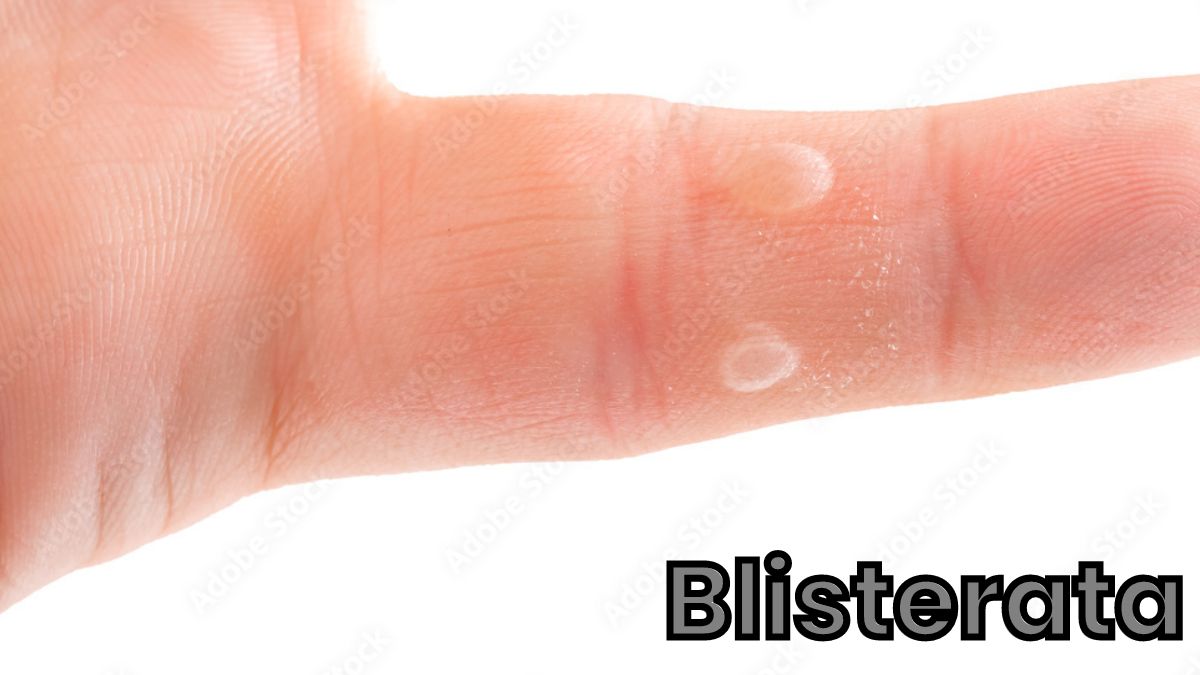HEALTH
Understanding Blisterata: Causes, Symptoms, and Treatment Options

Welcome to our comprehensive guide on understanding Blisterata: Causes, Symptoms, and Treatment Options. If you’ve ever experienced the discomfort of blisters, you know how irritating they can be. In this blog post, we will delve into what causes Blisterata, its symptoms, holistic approaches to managing it, treatment options available, prevention strategies to keep them at bay, and potential complications that may arise. So let’s jump right in and equip ourselves with the knowledge needed to tackle Blisterata effectively!
Overview of Blisterata
Blisterata is a skin condition characterized by the formation of blisters on the body’s surface. These blisters can be painful and uncomfortable, leading to distress for those affected. The condition can occur due to various factors, including friction, burns, allergies, infections, or underlying medical conditions.
Understanding Blisterata involves recognizing its symptoms and seeking appropriate treatment. It is essential to address the root cause of the blisters to effectively manage this condition and prevent complications. If you notice any signs of blister formation on your skin, it is crucial to consult with a healthcare professional for proper evaluation and care.
Causes of Blisterata
Blisterata, a condition characterized by the formation of blisters on the skin, can be caused by various factors. One common cause is friction or pressure on the skin, leading to irritation and blister formation. This could result from ill-fitting shoes or repetitive rubbing against clothing or equipment during physical activities.
Additionally, burns, insect bites, allergic reactions, and certain medical conditions like herpes simplex virus can also trigger blister formation. Understanding these underlying causes is crucial in effectively managing and treating Blisterata to prevent further discomfort and complications for individuals experiencing this condition.
Symptoms of Blisterata
Blisterata can manifest through various symptoms that may vary depending on the underlying cause. Common signs of Blisterata include painful blisters, redness, swelling, and tenderness in the affected area. These blisters are filled with fluid and can be itchy or uncomfortable.
Individuals with Blisterata may also experience a burning sensation, skin discoloration, or even fever in severe cases. It’s essential to monitor these symptoms closely and seek medical attention if they persist or worsen over time to receive proper diagnosis and treatment.
Holistic Approaches to Managing Blisterata
When it comes to managing Blisterata, holistic approaches can play a significant role in promoting overall well-being. Embracing a holistic lifestyle involves addressing not just the physical symptoms but also the emotional and mental aspects of health.
Practices like yoga, meditation, acupuncture, and herbal remedies can help reduce stress levels and boost the immune system, which may aid in preventing flare-ups of Blisterata. Additionally, maintaining a balanced diet rich in anti-inflammatory foods and staying hydrated are simple yet effective ways to support your body’s natural healing processes.
Treatment Options for Blisterata
When it comes to treating Blisterata, there are several options available depending on the severity of the condition. For mild cases, over-the-counter creams and ointments can help alleviate symptoms and promote healing. These products often contain ingredients like hydrocortisone or aloe vera to soothe the affected area.
In more severe cases, prescription medications such as antiviral drugs may be necessary to combat the underlying cause of Blistera. In some instances, doctors may also recommend procedures like laser therapy or cryotherapy to remove stubborn blisters and prevent further outbreaks. Consulting with a healthcare professional is essential to determine the most suitable treatment plan for each individual case of Blisterata.
Prevention Strategies for Blisterata
Preventing Blisterata involves simple yet effective strategies that can help reduce the risk of developing blisters. One key prevention method is wearing proper footwear that fits well and provides adequate support to avoid friction and pressure on the skin. Additionally, keeping feet clean and dry, especially during physical activities or in hot weather, can help prevent moisture-related blisters.
Regularly inspecting your feet for any signs of irritation or redness can aid in early detection and prompt treatment to prevent blisters from worsening. Using protective bandages or blister pads on areas prone to rubbing can also act as a barrier against friction, reducing the likelihood of blister formation.
Complications and Recovery
Complications may arise if Blistera is left untreated or not managed effectively. Potential complications include infection, scarring, and prolonged discomfort. It’s essential to address any signs of infection promptly to prevent further issues.
Recovery from Blistera can vary depending on the severity of the condition and individual factors. With proper treatment and care, most cases of Blisterata resolve within a few days to weeks. Following healthcare provider instructions, maintaining good hygiene practices, and implementing preventive measures can aid in a smooth recovery process.
Conclusion
Understanding Blisterata is crucial for early detection and effective management. By recognizing the causes, symptoms, treatment options, and prevention strategies outlined in this article, individuals can take proactive steps to address this condition. Whether opting for holistic approaches or seeking medical interventions, it is essential to prioritize self-care and seek professional guidance when needed. With proper care and attention, individuals can effectively manage Blisterata and minimize its impact on their daily lives. Stay informed, stay proactive, and prioritize your health to navigate through the challenges associated with Blistera successfully.

HEALTH
How Much Does a Non-Medical Home Care Business Make? A Comprehensive Guide

If you’ve been considering starting a non-medical home care business, one of the most pressing questions on your mind is likely, “How much can I make?” The home care industry has grown significantly in recent years, driven by an aging population and a rising preference for at-home care solutions. But what does this mean for your potential earnings? In this comprehensive guide, we’ll break down everything you need to know about the profitability of a non-medical home care business, including key factors that influence income, average revenue, and practical tips to maximize your earnings.
Whether you’re an aspiring entrepreneur looking to enter the healthcare sector or an established business owner exploring new ventures, this article will provide valuable insights into the financial prospects of a non-medical home care business.
Understanding the Non-Medical Home Care Industry
The non-medical home care sector provides services like companionship, assistance with daily activities, transportation, and personal care to seniors or individuals with disabilities. Unlike medical home care, which requires specialized medical staff, non-medical services do not involve clinical care, making it easier to start and operate the business.
- Industry Growth: According to recent data, the non-medical home care industry is expected to grow by over 7% annually, driven by the increasing elderly population. With more families looking for affordable, compassionate care solutions, this sector presents a promising business opportunity.
- Target Audience: Non-medical home care services primarily cater to seniors, but they are also beneficial for individuals recovering from surgery, those with chronic illnesses, or anyone needing extra assistance at home.
Factors Influencing Earnings
How much a non-medical home care business makes can vary significantly depending on several factors:
- Location: Businesses in urban areas tend to earn more due to higher service demand and pricing flexibility. Conversely, rural areas may have less competition but also fewer clients.
- Service Range: Offering specialized services like dementia care, overnight stays, or post-operative support can help increase revenue. The more diverse your services, the broader your client base.
- Business Model: Franchise owners may have to pay fees, reducing their profit margins, but they benefit from brand recognition. Independent owners keep more of their earnings but must invest more in marketing and brand building.
- Client Retention: The longer clients stay with your service, the more consistent your revenue stream will be. Building trust and offering high-quality care can lead to long-term client relationships.
Average Income for Non-Medical Home Care Businesses
On average, a small to mid-sized non-medical home care business can earn between $50,000 and $300,000 annually. However, the earnings can exceed $1 million per year for more extensive operations with multiple branches. Let’s break down these figures:
- Revenue per Client: Typically, home care businesses charge between $20 and $35 per hour, depending on the services offered and the location. For instance, providing basic companionship services might be priced lower than more intensive care such as bathing or mobility assistance.
- Monthly Earnings: If a business has 10 clients who require 20 hours of care per week, charging an average of $25 per hour, that equates to roughly $20,000 in revenue per month. Subtracting costs such as employee wages, transportation, and supplies will give a clearer picture of net income.
How to Increase Profitability in Your Business
- Diversify Your Services: Expanding beyond basic care to include additional services like transportation to appointments, meal preparation, and companionship can attract more clients and increase your revenue per client.
- Invest in Marketing: Build a strong online presence through social media, SEO-optimized websites, and local advertising. Creating informative content (like blog posts!) can help establish your business as a trusted local service provider.
- Optimize Operations: Efficient scheduling, effective training programs, and maintaining a reliable team of caregivers can help reduce costs and improve client satisfaction.
- Build Strong Client Relationships: Happy clients are more likely to recommend your services to others. Word-of-mouth referrals remain one of the most effective marketing tools in the home care business.
Start-Up Costs and Ongoing Expenses
Before delving into the potential profits, it’s essential to understand the costs associated with running a non-medical home care business:
- Initial Investment: Start-up costs can range from $10,000 to $100,000, depending on whether you’re buying into a franchise, leasing an office space, or starting from scratch. These costs include licensing, insurance, marketing, and initial employee training.
- Ongoing Expenses: The bulk of ongoing expenses are wages for caregivers, which account for 50-70% of the business costs. Other expenses include insurance, marketing, transportation, and supplies.
Real-World Examples and Success Stories
- Case Study 1: A home care business in California started as a small operation with just three caregivers. By focusing on specialized dementia care and partnering with local senior centers, they were able to grow their client base quickly. Within five years, they had expanded to three locations, with annual earnings surpassing $800,000.
- Case Study 2: An independent home care agency in Texas achieved success by offering 24/7 care packages, which appealed to clients needing consistent support. Their strategic use of online marketing helped them grow rapidly, hitting $400,000 in revenue within the first three years.
Conclusion
Starting a non-medical home care business can be a rewarding and profitable venture, especially in today’s growing market. By understanding the factors that influence profitability and employing strategic approaches to client care and business management, you can build a thriving operation. Ready to start your journey in the home care industry? Contact us today for a free consultation on how to kickstart your business.
FAQs
How much does it cost to start a non-medical home care business?
Start-up costs can range from $10,000 to $100,000, depending on factors like location, franchise fees, and initial staffing requirements.
What are the average hourly rates for non-medical home care services?
Hourly rates typically range from $20 to $35, varying based on service type and location.
Can I run a non-medical home care business from home?
Yes, many owners start from home to reduce overhead costs, but you may need a dedicated office space as you scale up.
Is a license required to start a non-medical home care business?
Licensing requirements vary by state. Be sure to check local regulations to ensure compliance.
What are the key skills needed to run a successful non-medical home care business?
Strong organizational skills, compassion, effective communication, and the ability to manage and motivate a team are essential for success.
HEALTH
The Ultimate Guide to Bananas: Nature’s Superfood

Bananas are more than just a popular fruit; they are a powerhouse of nutrition, flavor, and versatility. Known for their vibrant yellow color and sweet taste, bananas have secured a special place in our hearts and kitchens. But did you know that these delightful fruits offer a plethora of health benefits, culinary uses, and interesting facts? In this comprehensive guide, we will explore everything you need to know about bananas, from their nutritional profile and health benefits to their role in cooking and baking. Whether you’re a banana lover or just curious about this fantastic fruit, this post is packed with valuable insights that will enhance your appreciation for bananas.
What Are Bananas?
Bananas belong to the genus Musa and are one of the most cultivated fruits in the world. They are primarily grown in tropical regions, with countries like India, China, and the Philippines leading in production. The most common variety, the Cavendish banana, accounts for about 47% of global banana production.
Nutritional Profile
Bananas are rich in essential nutrients, making them a great addition to a balanced diet. Here’s a breakdown of their nutritional composition per medium-sized banana (approximately 118 grams):
- Calories: 105
- Carbohydrates: 27 grams
- Fiber: 3 grams
- Protein: 1.3 grams
- Fat: 0.3 grams
- Vitamin C: 17% of the Daily Value (DV)
- Vitamin B6: 20% of the DV
- Potassium: 12% of the DV
This impressive nutrient profile makes bananas an excellent source of energy, particularly for athletes and active individuals.
Health Benefits of Bananas
Heart Health
Bananas are an excellent source of potassium, a mineral essential for heart health. Adequate potassium intake helps regulate blood pressure, reducing the risk of heart disease and stroke. Research suggests that diets rich in potassium can lower blood pressure levels and enhance overall cardiovascular function.
Digestive Health
The dietary fiber in bananas aids digestion and promotes gut health. Fiber helps regulate bowel movements and can alleviate constipation. Additionally, bananas contain a type of fiber called pectin, which may help improve gut health and reduce bloating.
Energy Boost
Thanks to their natural sugars—fructose, glucose, and sucrose—bananas provide a quick energy boost. They are a popular choice among athletes for pre- and post-workout snacks. Eating a banana before a workout can enhance performance and stamina.
Mood Enhancement
Bananas contain tryptophan, an amino acid that the body converts into serotonin, a neurotransmitter known for promoting feelings of well-being and happiness. Consuming bananas may help improve mood and reduce symptoms of depression.
Weight Management
Bananas can support weight management efforts. Their high fiber content promotes a feeling of fullness, helping to control appetite and reduce overall calorie intake. Including bananas in your diet can help you feel satisfied without consuming excessive calories.
Culinary Uses of Bananas
Bananas are incredibly versatile in the kitchen. Here are some popular ways to incorporate them into your meals:
Smoothies
Bananas add creaminess and natural sweetness to smoothies. Combine them with spinach, yogurt, and your favorite fruits for a nutritious and delicious drink.
Baking
Bananas are a key ingredient in many baked goods, including banana bread, muffins, and pancakes. Their natural sweetness can often reduce the need for added sugars in recipes.
Snacks
Enjoy bananas on their own as a quick and convenient snack. You can also slice them onto cereal, oatmeal, or yogurt for added flavor and nutrition.
Desserts
Use bananas in desserts like banana splits, puddings, or as toppings for ice cream. Their sweetness and texture make them a perfect complement to various treats.
Savory Dishes
While bananas are primarily sweet, they can also be used in savory dishes. Consider adding them to stir-fries or salads for a unique flavor contrast.
Fun Facts About Bananas
- Botanical Classification: Surprisingly, bananas are classified as berries, while strawberries are not!
- Radioactive: Bananas contain potassium-40, a radioactive isotope. However, the levels are so low that they are harmless to humans.
- Ripening Process: Bananas produce ethylene gas, which accelerates the ripening process. You can ripen green bananas by placing them in a paper bag.
- Cavendish Dominance: The Cavendish variety accounts for nearly half of the global banana production, making it susceptible to diseases like the Panama disease.
- Cultural Symbolism: In some cultures, bananas symbolize fertility and prosperity, making them popular gifts for various occasions.
Conclusion
Bananas are not just a tasty fruit; they are a nutritional powerhouse with numerous health benefits and culinary applications. Their versatility makes them a staple in many households, while their unique properties contribute positively to overall health. By incorporating bananas into your diet, you can enjoy their delicious flavor while reaping the rewards of their nutritional benefits. So, next time you reach for a snack, consider grabbing a banana!
FAQs
Are bananas good for weight loss?
Yes, bananas can support weight loss efforts due to their fiber content, which promotes a feeling of fullness and helps control appetite.
Can bananas be eaten by diabetics?
While bananas contain natural sugars, they can be consumed in moderation by diabetics. Their fiber content can help regulate blood sugar levels.
How can I keep bananas fresh longer?
To prolong the freshness of bananas, store them in a cool, dry place away from direct sunlight. You can also separate them from the bunch to slow down the ripening process.
Are there any health risks associated with eating bananas?
For most people, bananas are safe to eat. However, those with certain allergies or conditions, such as latex allergies, may need to avoid them.
What is the best way to eat bananas?
Bananas can be enjoyed raw, in smoothies, baked goods, or as toppings. They are versatile and can be incorporated into a variety of dishes.
HEALTH
Transform Your Mobile Home with Kingymab: The Ultimate Guide to Modern Exteriors

Are you looking to upgrade the look and functionality of your mobile home? If so, you’re in the right place! In this comprehensive guide, we will explore the amazing world of Kingymab, a leading name in mobile home exteriors, and show you how to enhance your living space with style and sophistication. From innovative design ideas to practical tips for maintenance, this post will cover everything you need to know to make informed decisions about your mobile home’s exterior.
Introduction: Why Mobile Home Exteriors Matter
When it comes to mobile homes, the exterior plays a crucial role in both aesthetics and functionality. A well-maintained exterior not only enhances curb appeal but also protects your home from the elements. Kingymab offers a range of solutions to help you achieve both these goals, ensuring that your mobile home stands out and remains in top condition for years to come.
In this guide, we’ll dive deep into Kingymab’s offerings, compare them with other options available in the market, and provide you with actionable tips to transform your mobile home’s exterior.
What Makes Kingymab Stand Out?
Kingymab is known for its cutting-edge design solutions that blend form and function. Their product line includes a variety of siding materials, roofing options, and decorative elements designed to suit various styles and preferences. Whether you’re looking for a modern, sleek look or a more traditional aesthetic, Kingymab has something to offer.
- Siding Materials: Kingymab offers high-quality siding options such as vinyl, metal, and fiber cement. Each material has its unique benefits, from durability to energy efficiency.
- Roofing Solutions: Kingymab’s roofing options are designed to withstand harsh weather conditions while enhancing the overall look of your mobile home. They provide various styles, including shingles, metal roofing, and more.
- Decorative Elements: To add a personal touch, Kingymab provides a range of decorative elements such as trim, shutters, and skirting that can be customized to fit your home’s style.
Quality and Durability
One of the standout features of Kingymab products is their commitment to quality and durability. Their materials are engineered to withstand extreme weather conditions and resist common issues such as rot and fading. This means you can enjoy a beautiful exterior without the constant need for repairs and maintenance.
- Weather Resistance: Kingymab products are designed to endure harsh weather conditions, including heavy rain, snow, and UV rays.
- Low Maintenance: Thanks to their high-quality materials, Kingymab exteriors require minimal maintenance, saving you time and money in the long run.
Customization Options
Kingymab understands that every homeowner has unique tastes and preferences. That’s why they offer a range of customization options to help you create a look that’s uniquely yours. From color choices to design patterns, you can tailor every aspect of your mobile home’s exterior to match your vision.
- Color Palettes: Choose from a wide range of colors to match your home’s style and surroundings.
- Design Patterns: Select from various design patterns and textures to add visual interest and personality to your exterior.
Comparing Kingymab to Competitors
To ensure you’re making the best choice for your mobile home’s exterior, it’s important to compare Kingymab with other options available in the market. Let’s take a look at how Kingymab stacks up against the competitors.
Kingymab vs. Other Mobile Home Exterior Providers
- Kingymabs.com: While Kingymabs.com offers a range of exterior solutions, it lacks the comprehensive customization options and high-quality materials that Kingymab provides. Kingymab’s products are more durable and require less maintenance, making them a better long-term investment.
- Kingymab.com: Kingymab.com provides some similar products but does not offer the same level of design innovation and customization as Kingymab. Kingymab’s focus on quality and unique design options sets it apart from this competitor.
- Pinterest Kingymab: Pinterest Kingymab showcases various design ideas and inspirations but lacks detailed information on product specifications and durability. Kingymab’s website provides a more in-depth look at their products, helping you make an informed decision.
Tips for Choosing the Right Exterior for Your Mobile Home
Selecting the right exterior for your mobile home can be a daunting task, but with these tips, you can make a more informed decision:
Consider Your Climate
The climate in your area plays a significant role in determining the best exterior materials for your mobile home. For example, if you live in a region with heavy snowfall, you’ll want materials that can withstand snow and ice.
Evaluate Maintenance Requirements
Some materials require more maintenance than others. If you prefer a low-maintenance option, consider materials such as vinyl or metal siding, which are designed to resist fading and damage.
Think About Aesthetics
Your mobile home’s exterior should reflect your personal style and complement your home’s architecture. Take the time to explore different design options and color palettes to find the perfect match.
Budget Wisely
While it’s important to invest in quality materials, it’s also essential to stay within your budget. Kingymab offers a range of products at various price points, so you can find a solution that fits your financial constraints.
Seek Professional Advice
If you’re unsure about which materials or designs will work best for your mobile home, consider consulting with a professional. They can provide expert recommendations and help you make the best choice for your needs.
Conclusion
Upgrading your mobile home’s exterior is a fantastic way to enhance its appearance and functionality. Kingymab offers a wide range of innovative and durable solutions that can transform your home into a stylish and comfortable living space. By considering factors such as climate, maintenance, aesthetics, and budget, you can make an informed decision that will benefit you for years to come.
FAQs
What types of exterior materials does Kingymab offer?
kingymabKingymab provides a variety of exterior materials including vinyl, metal, and fiber cement siding. Each option is designed to offer durability and aesthetic appeal to suit different styles and preferences.
How does Kingymab ensure the durability of its products?
Kingymab’s products are engineered to withstand harsh weather conditions and resist common issues such as rot and fading. Their materials are rigorously tested for durability, ensuring long-lasting performance.
Can I customize the design of my mobile home’s exterior with Kingymab?
Yes, Kingymab offers extensive customization options. You can choose from various colors, design patterns, and decorative elements to tailor the exterior of your mobile home to your personal style.
Are Kingymab products low maintenance?
Absolutely. Kingymab’s materials are designed for low maintenance, reducing the need for frequent repairs and upkeep. Products like vinyl and metal siding are particularly resistant to fading and damage.
How do I choose the best exterior material for my climate?
Consider the climate in your area when selecting exterior materials. Kingymab’s experts can provide recommendations based on your specific weather conditions, helping you choose materials that will perform well in your environment.

 CRYPTO3 months ago
CRYPTO3 months agoCrypto-Engine.Pro Blog: Your Go-To Source for Crypto Trading Insights

 GENERAL3 weeks ago
GENERAL3 weeks agoUnderstanding TNA Board: A Comprehensive Guide for Beginners

 GENERAL4 months ago
GENERAL4 months agoEverything You Need to Know About NSFW411: The Ultimate Guide

 ENTERTAINMENT4 months ago
ENTERTAINMENT4 months agoExploring Mywape: Your Guide to Quality Vaping

 FOOD5 months ago
FOOD5 months agoExploring the Benefits of süberlig: A Comprehensive Guide

 BLOG4 months ago
BLOG4 months agoDiscover the Secrets Behind the /vital-mag.net blog: A Closer Look at the Popular Blog

 FOOD5 months ago
FOOD5 months agoUnveiling the Beauty of Tamisie: A Guide to this Exquisite Fabric

 ENTERTAINMENT4 months ago
ENTERTAINMENT4 months agoNavigating Erome: Tips and Tricks for a Safer Experience on Adult Platforms




















